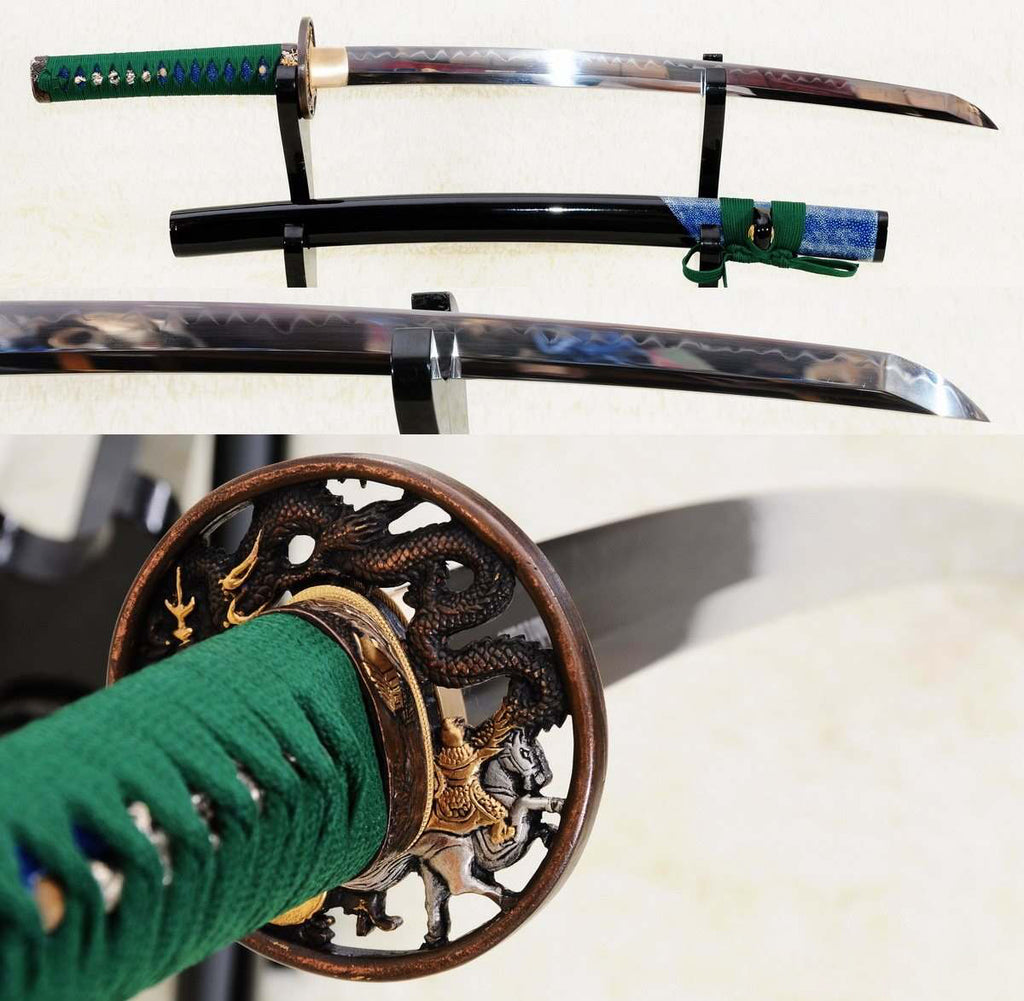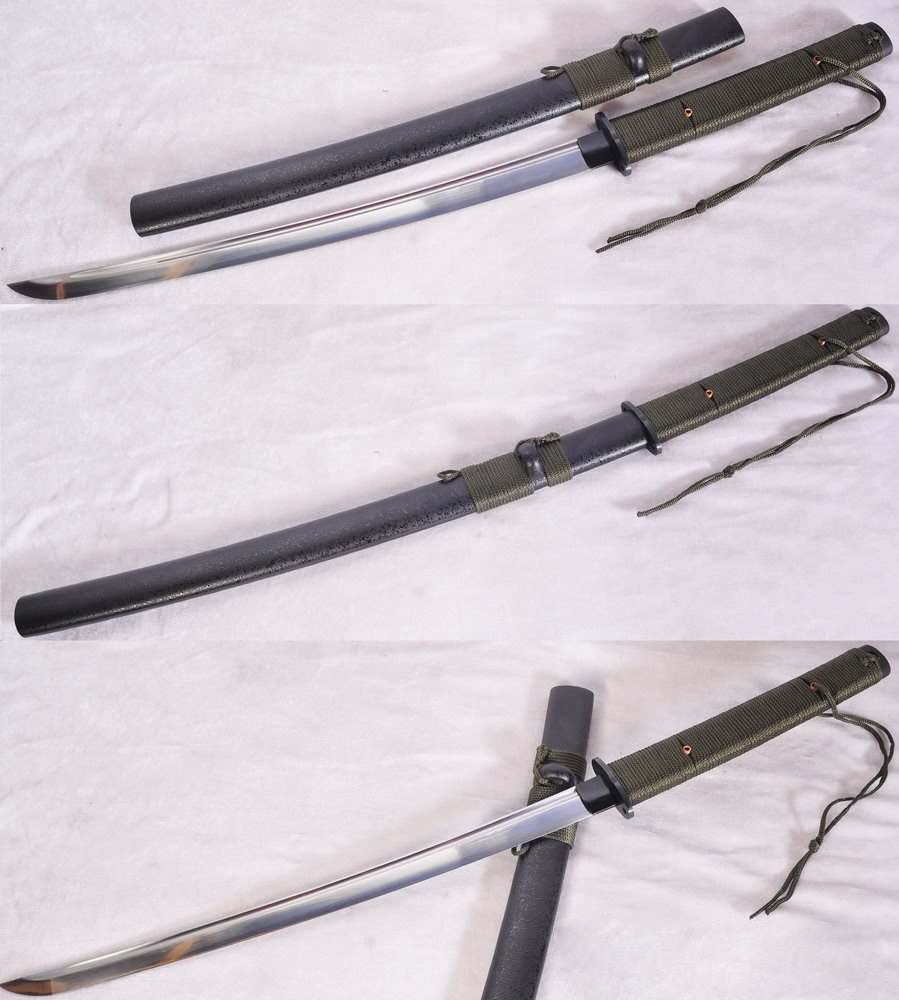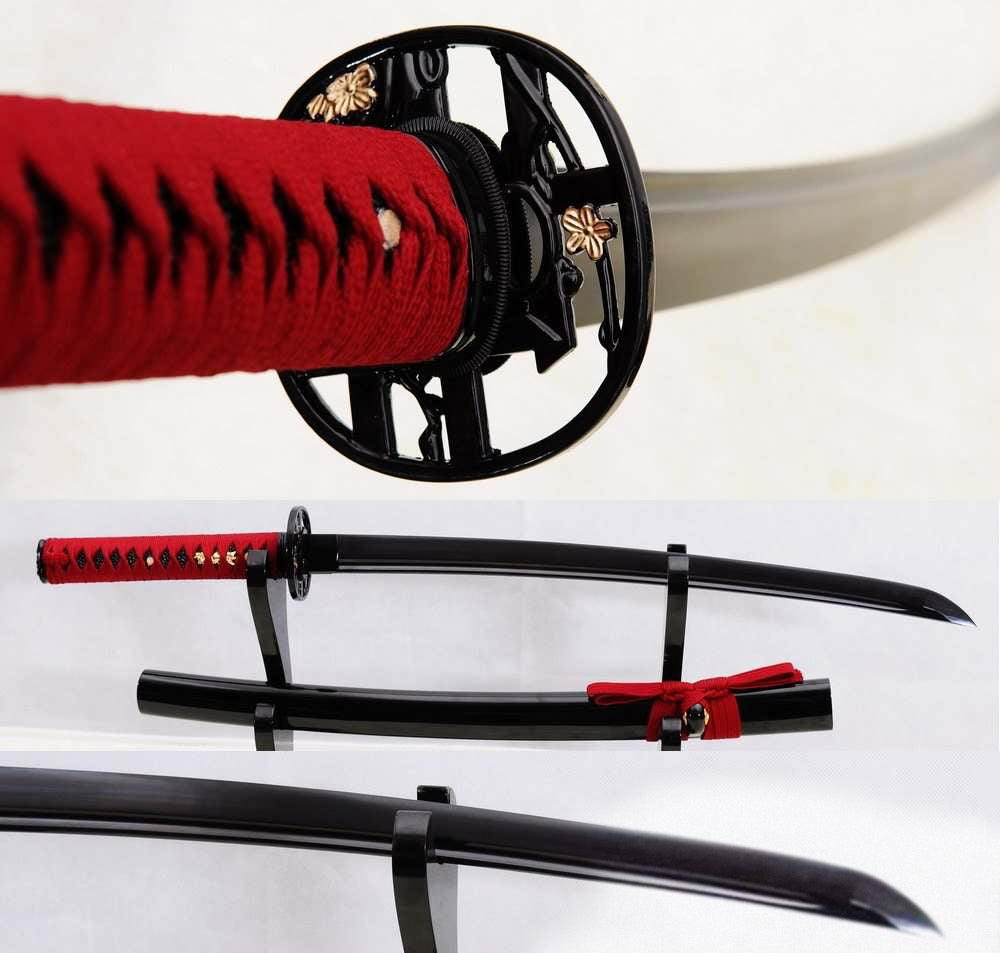We may earn revenue from the products available on this page and participate in affiliate programs. Learn more >
Recognized as one of the most effective Japanese sword types, the wakizashi was a common sight among samurai on the battlefield. Indeed, numerous researchers posit that it was utilized more often than any other Japanese type, even more so than the iconic katana. What made the wakizashi so effective was its balanced size. It wasn’t too long or too short, making it perfect as a main weapon in small areas where bigger blades were hard to use, or as a backup when needed. It could cut and thrust. It was lightweight and fast to use. And, it was useful to complete many other daily tasks that required a sharp edge.
Here’s the thing with modern blades: many sellers say they’re made the old, traditional way, or call them authentic. But most of the time, that’s just not true. How do we know? Because when bringing them to the test, they lack performance. In this post, we will share our research and recommendations for the best wakizashis you can add to your collection, use them for martial arts, or other applications.
- Best Overall: Bessho Nagaharu
- Best Budget-Friendly: T10 MURASAME Wakizashi
- Best for Heavy cutting: Bamboo Mat Wakizashi
- Best Tactical Wakizashi: Higashiōsaka
- Best for Dojo Students: Hanwei Practical Wakizashi
- Best for Iaido: Kumamoto
How We Chose the Best Wakizashi Swords

Samurai swords are very popular nowadays, and as a result, the market is full of all kinds of wakizashi swords, with quality varying greatly from one to another. Some can cost less than $100, while others go over $1,000. To make this list, we started by researching the most popular wakizashi swords available. We looked at what collectors, martial artists, and regular people who own these swords were actually saying. We considered every advantage and disadvantage. Then we narrowed it down to the ones with strong feedback from multiple sources.
If different fellows praised a sword, it was a good sign that it wasn’t just a one-off opinion. Next, we focused on what truly matters in a good wakizashi. Things like forging methods (traditional or not), fitting quality, design, and performance. We mainly focused on swords from well-known forges like Hanwei and trusted Longquan smiths, as these makers are recognized for producing some of the best functional wakizashis (according to both experts and collectors). We also looked at other factors like build quality, full tang construction for strength, visible hamon lines, and so on.
Finally, our analysis allowed us to assign each sword to its best use case. For example, if multiple reports indicated a sword’s excellent edge retention during heavy cutting, we marked it as ideal for that specific purpose. That way, you can find the right wakizashi based on what you plan to do with it.
Best Wakizashi Swords: Reviews & Recommendations
Best Overall: Bessho Nagaharu

SPECIFICATIONS
| Overall Length | 85 cm (33.5″) |
| Blade Length | 50 cm (19.7″) |
| Weight | 725 g |
| Blade Material | 1095 High Carbon Steel |
| Usage | Fully functional |
| Price | $439 |
Pros
- Elaborate tsuba
- Designed for heavy cutting
- Made using traditional methods
- Natural hamon
- Offers customization
Cons
- None
The Bessho Nagaharu is a traditional wakizashi made by Longquan swordsmiths using traditional techniques. When you open the box, you’ll see the stunning hamon on the blade, which comes from the clay tempering process. The blade is 50 cm long, and the handle adds another 27 cm. This samurai wakizashi can be used for various purposes, such as cutting, survival, or martial arts. It has a unique circular tsuba with a horse and dragon design.
The blade is made of 1095 high-carbon steel, full tang, and hand-sharpened, suitable for battle and durable enough for cutting tameshigiri, bamboo, bones, and more. The sword comes with silk sageo/ito, genuine same’ (rayskin) and premium engraved copper fittings. The saya is made of hardwood and partially wrapped with genuine rayskin. Bessho is valued as a mid-level katana, priced at $439, and is available exclusively through the SON website.
Best Budget-Friendly: T10 MURASAME Wakizashi
SPECIFICATIONS
| Overall Length | 30.7 inch/78 cm |
| Blade Length | 19.7 inch/52 cm |
| Weight | 620 g |
| Blade Material | T10 steel |
| Usage | Fully functional |
| Price | $189 |
Pros
- Great for beginners
- Lightweight
- Affortable
- Fully functional
- Offers customization
Cons
- Not suited for cutting strong targets
If you’re looking for a functional wakizashi under $200, the Marasamune is easily one of the best options I’ve found on Amazon at this price. The build quality is genuinely impressive for the category: you’ll find active and prominent hamon, a well-executed leather wrap, a good saya, and even decent fittings, which is a common point noted by buyers.
Powering its performance is a blade made of T10 high carbon steel, known for its robust cutting capabilities – making this sword suitable for real cutting and Tameshigiri right out of the box. The overall design looks good. The tsuba is circular but lacks high detail.
The tsuka has a wood core wrapped in real ray skin, featuring a traditional leather ito wrap, and is secured by two mekugi (pegs). While I didn’t uncover any serious complaints, many customer reviews suggest this would be an excellent choice for your first functional wakizashi, particularly if a functional blade is what you’re seeking.
Best for Heavy Cutting: Bamboo Mat Wakizashi
SPECIFICATIONS
| Overall Length | 25.5 inch/ 65 cm |
| Blade Length | 18.5 inch/ 47 cm |
| Weight | 680 g |
| Blade Material | HWS-2S steel |
| Usage | Fully functional- heavy cutting |
| Price | $805 |
Pros
- Best for heavy cutting
- Great looking hamon
- Durable
Cons
- It may be pricey for some
- No custom options
Designed as a companion to the Hanwei Bamboo Mat Katana, this wakizashi is an excellent choice for heavy cutting. Forged from Hanwei’s high-alloy HWS-2S steel at their modern factory using high-tech equipment, it offers superior edge retention and durability. Not often found in blades, O-choji hamon is what you will find in this edge. So, if you want a cool hamon for your wakizashi, this is the one.
A bamboo theme is prominent among the fittings, appearing on the black iron tsuba (which features a bamboo mat texture, jointed rim, and gold-tipped leaf accents), the fuchi, and the kashira. Separate from this, the golden menuki showcase a pair of sparrows. The saya is finished in high-gloss lacquer and fitted with horn details.
Best Tactical Wakizashi: Higashiōsaka

SPECIFICATIONS
| Overall Length | 33.5 inch/ 85 cm |
| Blade Length | 19.7 inch/ 50 cm |
| Weight | 725 g |
| Blade Material | 1095 High Carbon Steel |
| Usage | Outdoor, Survival, Collections, Marital Arts, Home-defense |
| Price | $246 |
Pros
- Effective for multiple tasks and applications
- Classic wakizashi design
- Offers customization
- Olive green handle wrap looks amazing
- Ideal for outdoor use
Cons
- 1095 HCS requires maintenance regularly
- Small guard
In our article on the best tactical swords, the Higashiosaka was our best overall pick, recognized for its quality and affordable price. Modern tactical wakizashis such as the Higashiosaka are better suited for outdoor and survival use due to their lack of traditional fittings, though they are also perfectly fine if you want one for collectction. The sword itself is forged from durable 1095 high carbon steel following traditional Japanese techniques and features a full tang for extra strength.
An olive green nylon cord is wrapped around the handle for a good grip. Two iron pegs keep it tight. It comes complete with a black matte hardwood Saya. The blade does not have traditional details like hamon since it is made with functionality in mind however, it includes a groove (bo-hi) which makes it lighter and more balanced.
Best for Dojo Students: Hanwei Practical Wakizashi
SPECIFICATIONS
| Overall Length | 27.5 inch/ 70 cm |
| Blade Length | 20 inch/ 50 cm |
| Weight | 680 g |
| Blade Material | High Carbon Steel |
| Usage | Cutting excercises |
| Price | $299 |
Pros
- Highly durable
- Cool looking hamon
- Suited for heavy cutting
Cons
- The blade may be thinner
- No customizations
Part of Hanwei’s Practical series, the Practical Wakizashi, together with the popular Practical Katana (SH1070) and Tanto (SH2254) from Paul Chen, gives martial artists a chance to own a Hanwei sword at an economy price. The Hanwei Practical Wakizashi stands out as a reliable choice for dojo students seeking a durable and affordable sword for cutting practice. It is built specifically to withstand tamishigiri practice.
Many holders highlight its strong performance in cutting applications over long periods. The blade is made of high-carbon steel and is differentially tempered with an HRC60 edge and HRC40 back, and it’s full tang. It features a prominent hamon, which makes it look authentic and appealing. The tsuba is a standout: smooth, minimal, and comfortable during extended use. The tsuka may look traditional, but the rayskin and wrappings might not be the best quality.
Best for Iaido: Kumamoto

SPECIFICATIONS
| Overall Length | 30.7 inch/ 77 cm |
| Blade Length | 19.7 inch/ 50 cm |
| Weight | 725 g |
| Blade Material | 1060 High Carbon Steel |
| Usage | Iaido & Light cutting(if sharpened) |
| Price | $189 |
Pros
- Affordable
- Cool black blade
- Sharpened or unsharpened
Cons
- Might be slightly heavier than aluminium wakizashis
Unlike many Iaido swords often made from zinc aluminum or stainless steel, we found Kumamoto to be a more traditional alternative that offers the right balance needed for regular Iaido and Kenjutsu use. Not only is it made of 1060 high carbon steel, which at some point can be used for cutting purposes, but it is still very affordable. The blade is black, which looks unique.
The handle is wrapped in red silk ito(which can also be customized) while the tsuba is moderately elaborate. The sword comes with a shiny black wooden saya (sheath), metal parts, real rayskin, and a silk-wrapped tsuka (handle). The Wakizashi is put together well, and the ito (cord) wrapping is tight and even. Since each sword is handmade, the details might vary a bit from one to another.
How to Chose a Samurai Wakizashi
Picking a wakizashi can be tricky because there are so many types. Even though they might look alike, there are key differences that matter a lot. Down below, we’ll quickly go over the most important things to think about when you’re buying a new wakizashi. This will help you pick the perfect one for what you need it for, whether it’s just to look at, for practice, or for actual cutting.
Intended Use
The primary factor in your wakizashi search should be how you intend to use it. The thing about these blades is that they are often directed more towards martial arts or collections, rather than other applications that require a sharp blade. I mean, yes, they can be used, but since they are expensive, it’s not the best idea for cutting branches or ropes with it. If you are an Iaido practitioner, it’s clear that you don’t need a sharp blade, rather a blunt, balanced wakizashi.
However, if you just want one for fun because they look cool or for display, it’s better to think if you can use it in the future. What I mean by this: Wakizashi replicas generally fall into three main categories based on their intended use. First, there are display-only models, which are not suitable for training or cutting. Second, functional replicas are designed for practical use, such as martial arts training or cutting exercises.
Third are Iaido (or Iaito) swords, which are perfectly balanced and made with lighter steels and quality fittings specifically for drawing practice. Crucially, these are intentionally unsharpened and therefore cannot be used for cutting exercises in the future. If you get a decorative wakizashi, you have to think that you cannot use it in the future to train with. However, if you get a real wakizashi for display, you can still train, cut, and even use it for self-defense, as they still make some of the best swords for home defense in modern days.
Blade Steel

The type of steel used for the blade is super important, especially if you plan to use your wakizashi for anything more than just looking at. You’ll want to check if it’s a common carbon steel like 1045, 1060, or 1095, or something tougher like spring steel (5160). For traditional looks, some blades use folded steel, which creates beautiful patterns. The quality of the steel directly affects how well the blade holds an edge and how strong it is.
Forging Method
The way a wakizashi blade is made, or its forging method, really affects its strength and how it performs. You’ll often hear about a few types. Some are machine-made, which are usually more affordable but might not have the same traditional feel or strength. Then there are hand-forged blades, which are a step up and offer better durability. The most traditional and often highest quality method is differentially hardened (also called clay tempered).
Tang

The tang is the part of the blade that extends inside the handle, and its construction is absolutely crucial for how strong and safe your wakizashi will be. For any sword you plan to use, even just for practice, you want a full tang design. This means the blade steel goes all the way through the handle to the very end, making the sword incredibly durable and preventing the blade from breaking off. On the other hand, a partial tang or rat tail tang only goes partway into the handle. These are much weaker and generally only suitable for decorative display pieces, as they can be dangerous if used.
Price & Value
Wakizashi prices and value vary hugely, making this a crucial shopping point. While higher prices often mean better materials and craftsmanship, the most expensive options rarely offer the same “bang for your buck” as their more affordable, functional counterparts. Below $150, you’re generally looking at display-only pieces. For simple, light-cutting functional options (not top quality), expect $150-$200. A decent functional or Iaido sword for regular practice usually runs $200-$700. Serious functional blades or collectible pieces start at $700 and go much higher, reflecting top-tier quality or history.
Last Words
There are decorative wakizashi made for display, functional wakizashi made for Iaido, and real samurai wakizashi, made for modern-day samurai. You can find really good functional types priced at less than $200, like the T10 Murasame wakizashi. Or, for fully functional (still affordable) options like the Bessho Nagaharu, which is not only great for cutting targets but also excellent for collection and martial arts. After you’ve chosen your ideal wakizashi, be sure to prioritize its regular cleaning and maintenance for lasting beauty and function.
Read: The Best Katana Cleaning Kits of 2025
FAQ
What is the best steel for a wakizashi?
Differentially hardened 1095 Carbon Steel and T10 Tool Steel are both excellent choices for sharp, high-performance cutting blades.
Is wakizashi better than katana?

Wakizashi is better in tight spaces or in close quarters, while a katana has more reach and is better in an open field. For a more detailed comparison, you can check Wakizashi vs. Katana.











